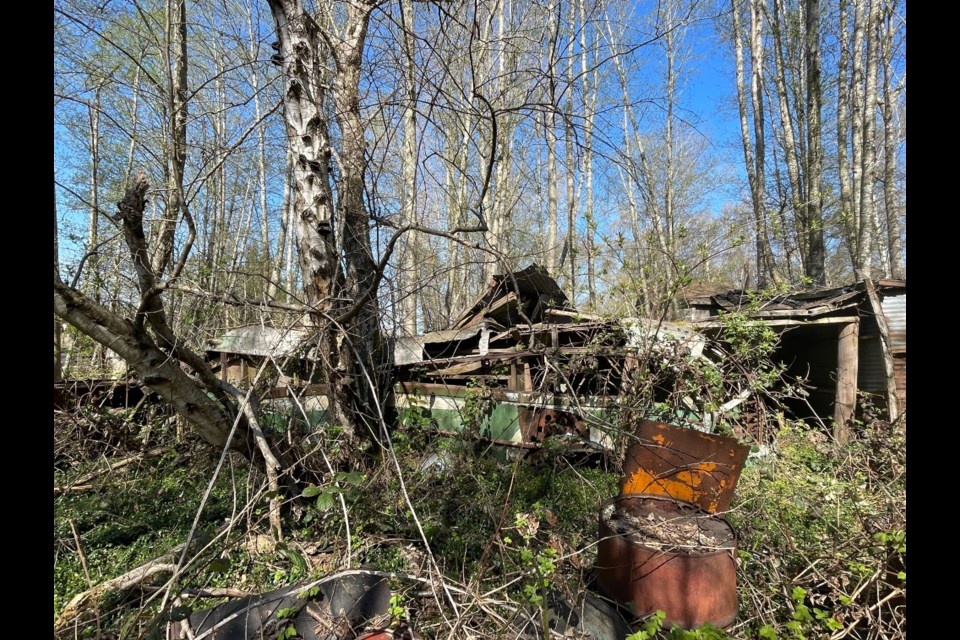Despite a slight visual of an abandoned peat farm from a main road in East Richmond, what’s hidden on the same plot of land is an even more rare piece of transportation history.
A vehicle hidden within dense thickets of thorn bushes and forested area is believed to be a 1935 Hayes-Anderson bus (model number 48) and the last of its model ordered by Pacific Stage Lines, originally known as BC Motor Transportation, a subsidiary of the BC Electric Railway.
Richmond resident Cato Leung is a local urban explorer looking for historical buildings and sites with a story to tell with the intention of documenting these historical places as a personal hobby.
The 17-year-old, Richmond Secondary student said his interest lies in exploring out-of-the-ordinary places and transportation history.
He often wonders why certain places look "weird or empty" and this has sparked a keen interest in urban exploration.
“I always have questions on why this and that place is abandoned and my parents, who immigrated here, were never able to answer them,” said Leung.
“Now that I have access to technology, I can find (the answers) myself and can go to these places myself. I’m just naturally curious.”
As of May, Leung has marked approximately 1,037 of these sites on a map of Metro Vancouver.
Leung conducts his research through the Richmond Archives, city council documents, online resources as well as searching out and talking to people with historical knowledge.
Finding and seeing the 1935 Hayes-Anderson bus, which is one of the oldest models of its line, in person was a long-time goal for Leung and after years of research and multiple tries, he finally found it in April.
As there was no direct path to the bus, Leung and his friend Carson Sturrock trekked through the dense forest for an hour and a half, only equipped with water, hiking boots, thick gloves and a pair of scissors, to reach the peat farm and finally see the bus with their own eyes.
He found out about the bus through other online urban explorers who had previously visited the site but was never given exact directions or a location where it was.
He told the Richmond News there were no visible “no trespassing” signs while he entered the area.
The slips and falls and multiple cuts from thorn bushes didn't stop either of them from continuing on their adventure - they said it was worth it in the end.
“After four, six years and many hours of research, one year of planning and multiple failed attempts we finally made it,” said Leung, adding it was initially difficult to spot as it was covered under many branches.
“Seeing photos is one thing, and actually seeing the real bus, although it has severely deteriorated, is another experience and feeling I can’t explain.”
The bus, Leung added, was on a parcel of East Richmond land with a long history of being mined for peat.
On June 3, 1946, an individual named Mel Shirley (T.M. Shirley) applied for a license to operate a peat plant on the East Richmond land and was granted a permit to operate the “Blundell Peat Company” between 1946 and the 1970s, according to documents from the Richmond Archives and a development proposal presented to Richmond city council in 2010.
It appears that Mel Shirley didn't live on the property and was actually living in Vancouver.
In 1958, a family moved onto the land as caretakers and lived in a white house on the property until 1972.
After the family moved out, the whereabouts of Mel Shirley were unclear as they either “died, retired or sold the land, with the house allegedly being put up for rent in the 1980s for only $125 per month," explained Leung.
“The only people living on the farm during its operation would have been land caretakers, who are all either now dead, undocumented or have asked to not have their family named,” he said.
The property is just one parcel of hundreds of acres in East Richmond owned by EcoWaste, which operates a demolition waste landfill and is currently building industrial buildings on decommissioned landfill sites.
It is unclear when the property was acquired by EcoWaste.
EcoWaste applied for a permit to pull the land out from the Agricultural Land Reserve (ALR) in May 2008.
A second application to exclude it from the ALR was submitted to convert it into a landfill and to redevelop a part of it as “wetlands” for a 30-year term to preserve wildlife habitat.
City council rejected this proposal as well.
The land is currently unused and is completely overgrown with the peat mine and abandoned bus hidden from the general public.
Got an opinion on this story or any others in Richmond? Send us a letter or email your thoughts or story tips to [email protected]. To stay updated on Richmond news, sign up for our daily headline newsletter.



